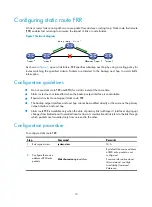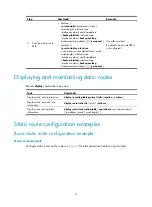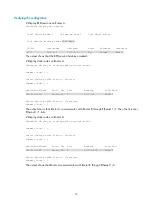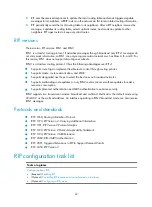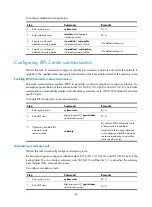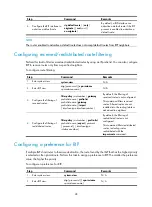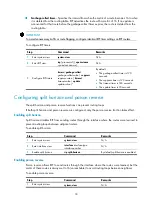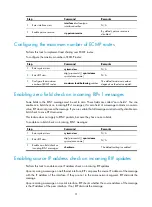
21
Configuring RIP
Routing Information Protocol (RIP) is a distance-vector IGP suited to small-sized networks. It employs UDP
to exchange route information through port 520.
Overview
RIP uses a hop count to measure the distance to a destination. The hop count from a router to a directly
connected network is 0. The hop count from a router to a directly connected router is 1. To limit
convergence time, RIP restricts the metric range from 0 to 15. A destination with a metric value of 16 (or
greater) is considered unreachable. For this reason, RIP is not suitable for large-sized networks.
RIP route entries
RIP stores routing entries in a database. Each routing entry contains the following elements:
•
Destination address
—IP address of a destination host or a network.
•
Next hop
—IP address of the next hop.
•
Egress interface
—Egress interface of the route.
•
Metric
—Cost from the local router to the destination.
•
Route time
—Time elapsed since the last update. The time is reset to 0 when the routing entry is
updated.
•
Route tag
—Used for route control. For more information, see "Configuring routing policies."
Routing loop prevention
RIP uses the following mechanisms to prevent routing loops:
•
Counting to infinity
—A destination with a metric value of 16 is considered unreachable. When a
routing loop occurs, the metric value of a route will increment to 16 to avoid endless looping.
•
Triggered updates
—RIP immediately advertises triggered updates for topology changes to reduce
the possibility of routing loops and to speed up convergence.
•
Split horizon
—Disables RIP from sending routing information on the interface from which the
information was learned to prevent routing loops and save bandwidth.
•
Poison reverse
—Enables RIP to set the metric of routes received from a neighbor to 16 and sends
these routes back to the neighbor so the neighbor can delete such information from its routing table
to prevent routing loops.
RIP operation
RIP works as follows:
1.
RIP sends request messages to neighboring routers. Neighboring routers return response
messages that contain their routing tables.




